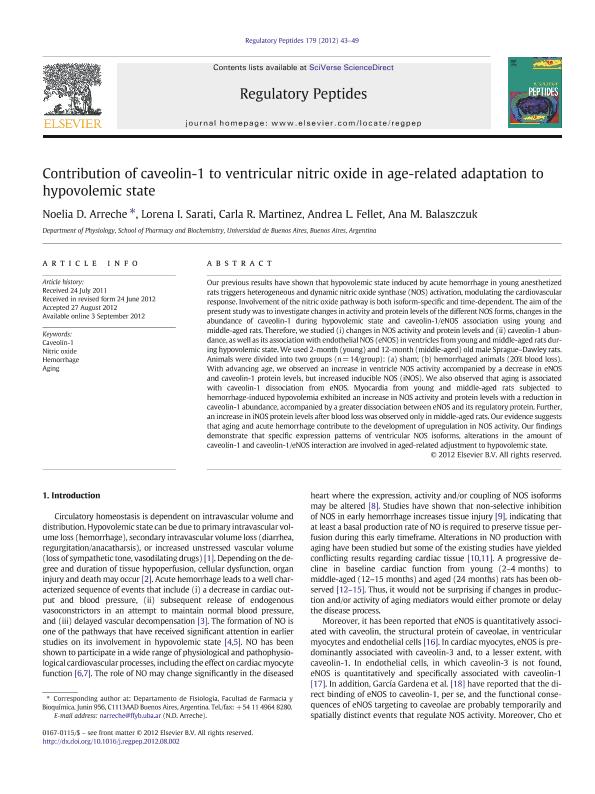Artículo
Contribution of caveolin-1 to ventricular nitric oxide in age-related adaptation to hypovolemic state
Arreche, Noelia Daniela; Sarati, Lorena Ivonne ; Martinez, Carla Romina; Fellet, Andrea L.
; Martinez, Carla Romina; Fellet, Andrea L. ; Balaszczuk, Ana María
; Balaszczuk, Ana María
 ; Martinez, Carla Romina; Fellet, Andrea L.
; Martinez, Carla Romina; Fellet, Andrea L. ; Balaszczuk, Ana María
; Balaszczuk, Ana María
Fecha de publicación:
11/2012
Editorial:
Elsevier Science
Revista:
Regulatory Peptides
ISSN:
0167-0115
Idioma:
Inglés
Tipo de recurso:
Artículo publicado
Clasificación temática:
Resumen
Our previous results have shown that hypovolemic state induced by acute hemorrhage in young anesthetized rats triggers heterogeneous and dynamic nitric oxide synthase (NOS) activation, modulating the cardiovascular response. Involvement of the nitric oxide pathway is both isoform-specific and time-dependent. The aim of the present study was to investigate changes in activity and protein levels of the different NOS forms, changes in the abundance of caveolin-1 during hypovolemic state and caveolin-1/eNOS association using young and middle-aged rats. Therefore, we studied (i) changes in NOS activity and protein levels and (ii) caveolin-1 abundance, as well as its association with endothelial NOS (eNOS) in ventricles from young and middle-aged rats during hypovolemic state. We used 2-month (young) and 12-month (middle-aged) old male Sprague-Dawley rats. Animals were divided into two groups (n. = 14/group): (a) sham; (b) hemorrhaged animals (20% blood loss). With advancing age, we observed an increase in ventricle NOS activity accompanied by a decrease in eNOS and caveolin-1 protein levels, but increased inducible NOS (iNOS). We also observed that aging is associated with caveolin-1 dissociation from eNOS. Myocardia from young and middle-aged rats subjected to hemorrhage-induced hypovolemia exhibited an increase in NOS activity and protein levels with a reduction in caveolin-1 abundance, accompanied by a greater dissociation between eNOS and its regulatory protein. Further, an increase in iNOS protein levels after blood loss was observed only in middle-aged rats. Our evidence suggests that aging and acute hemorrhage contribute to the development of upregulation in NOS activity. Our findings demonstrate that specific expression patterns of ventricular NOS isoforms, alterations in the amount of caveolin-1 and caveolin-1/eNOS interaction are involved in aged-related adjustment to hypovolemic state. © 2012 Elsevier B.V.
Palabras clave:
Aging
,
Caveolin-1
,
Hemorrhage
,
Nitric Oxide
Archivos asociados
Licencia
Identificadores
Colecciones
Articulos(IQUIMEFA)
Articulos de INST.QUIMICA Y METABOLISMO DEL FARMACO (I)
Articulos de INST.QUIMICA Y METABOLISMO DEL FARMACO (I)
Citación
Arreche, Noelia Daniela; Sarati, Lorena Ivonne; Martinez, Carla Romina; Fellet, Andrea L.; Balaszczuk, Ana María; Contribution of caveolin-1 to ventricular nitric oxide in age-related adaptation to hypovolemic state; Elsevier Science; Regulatory Peptides; 179; 1-3; 11-2012; 43-49
Compartir
Altmétricas



